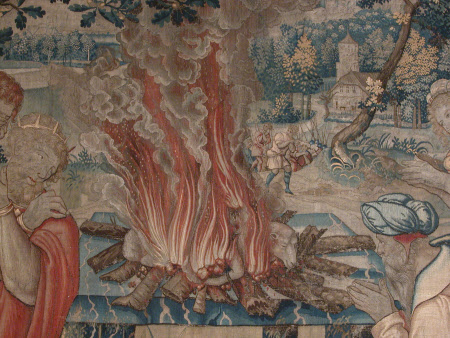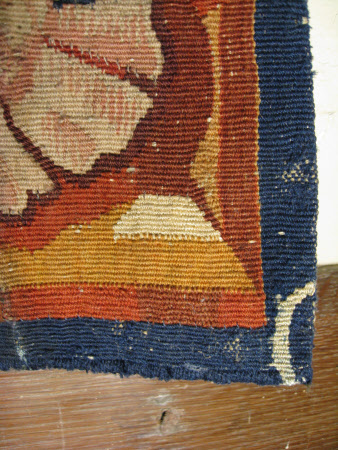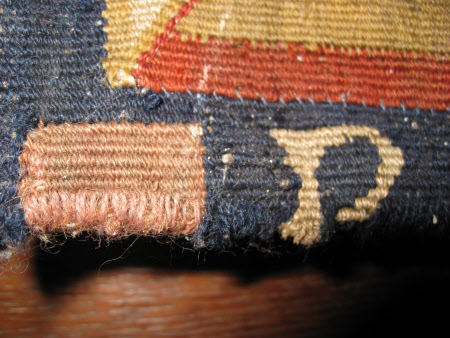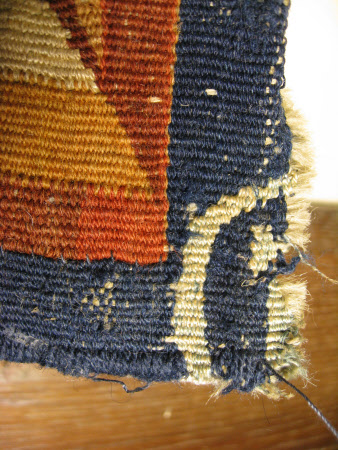The Sacrifice of Saul
Brussels
Category
Tapestries
Date
circa 1550 - circa 1575
Materials
Tapestry, wool and silk, 5½-6 warps per cm
Measurements
3230 x 3350 mm
Order this imageCollection
Packwood House, Warwickshire
NT 557905
Summary
Tapestry, wool and silk, 5½-6 warps per cm. The sacrifice of Saul, one of two from a History of Saul, Brussels, c. 1550-1575. A large square tapestry showing a sacrifice. In the centre red flames and smoke rise from a sacrificial lamb which is being burned on a pile of sticks on an altar formed of a veined marble slab on marble legs. To the left Saul wearing a red cloak over a leather tunic kneels with his arms crossed across his chest, a crown on his head and a sceptre lying before him on the ground; opposite him on the right an elderly man wearing a blue cloak over a pale red robe and a blue turban on his head also kneels, his hands together in front of him. An ornate blue vase stands on the ground between the two men. Behind Saul on the left is an oak tree and two more figures watching the sacrifice, and more figures look on from the right hand side. The scene takes place in a landscape and in the distance two figures can be seen approaching with their arms clasped across their bodies in terror, an army of men carrying pikes following them. The border is composed of bunches of leaves, fruit and flowers around a central palm trunk, on a ground which fades from red to pale beige with edges woven in imitation of a carved frame.
Full description
Saul was the first king of the people of Israel, appointed by the prophet Samuel according to the wishes of the Israelites. Samuel did not wish to appoint a King, but the Lord told him to do so as the people had rejected him as their judge. Saul soon displeased both Samuel and the Lord. The event depicted in this tapestry is probably the sacrifice made by Saul at Gilgal (I Samuel 13.9). The Israelites were gathered there in preparation for battle with the Philistines, but when they saw the huge army amassed by the Philistines many of Saul’s people fled (I Samuel 13.6). Samuel had arranged to meet Saul at Gilgal after seven days but when he did not appear Saul made a burnt offering in preparation for battle. As soon as Saul had made the burnt offering Samuel appeared, telling Saul that he had disobeyed the Lord by making this offering, and that now his Kingdom of Israel would not continue as the Lord had chosen another man (David) to be captain over his people (I Samuel 13.13-14). The man on the right hand side in the tapestry is probably Samuel, and the army in the background are the Philistines, two Israelites fleeing before them. The tapestry bears part of the mark of the city of Brussels on its lower border, and a partial maker’s mark at the bottom of the right hand edge. An even smaller fragment of the same mark, now folded under the lining, survives on ‘The Departure of Saul’. Both maker’s marks are too mutilated to be positively identified. The two tapestries probably come from a larger set of the History of Saul, or possibly of the History of David. No further weavings of these two designs have been located but a number of stylistically similar tapestries with related subject matter survive. These include a set of six tapestries of the ‘History of Saul’ in the Cathedral of Cuenca in Spain (Junquera 1973), and a set whose subject may be a ‘History of the Kings’ but which includes two scenes from the life of Saul, in the Residenz, Munich (Duverger 1969, pp. 134-141). Both these sets bear the mark of the Brussels weaver and entrepreneur François Geubels (fl. 1546-1585), and both have borders similar to the set at Packwood. François Geubels was one of the most important tapestry weavers in mid-sixteenth-century Brussels. His mark appears on a large number of surviving sets and he frequently subcontracted part of sets to different weavers, as was the case with the tapestry sets now at Munich and Cuenca which bear the mark of a second master weaver. It is possible that the two tapestries at Packwood were woven under his direction as well, although there is no way of knowing for sure. (Helen Wyld, 2010)
Provenance
The Marques of Zetland, Aske Hall; sold Tennants 21.09.1994, lot 917 and bought by the National Trust for Packwood House
Credit line
Packwood House, The Graham Baron Ash Collection (The National Trust)
Marks and inscriptions
Galloon, lower left: The mark of the city of Brussels, two capital Bs either side of a red shield. Only the upper part is visible, the rest has been folded under the lining
Makers and roles
Brussels , workshop
References
Cinq Siècles d’Art Bruxellois: tome II, dessins et tapisseries, exh. cat. Brussels 1935 Duverger, 1969: Erik Duverger, ‘Tapijtwerk uit het Atelier van Frans Geubels’, in De Bloeitijd van de Vlaamse Tapijtkunst, Internationaal Colloquium 23-25 Mei 1961, Brussels 1969, pp. 91-149 Thomson, 1973: W G Thomson, A History of Tapestry from the Earliest Times until the Present Day, 3rd edition, Wakefield 1973 Junquera 1973 P Junquera, ‘Los Tapices de la Catedral de Cuenca’, Archivo Español de Arte, vol. XLVI, no. 181 (1973), pp. 2-8 Forti-Grazzini, 1984: Nello Forti-Grazzini, Museo d'arti applicate. Arazzi (Musei e Gallerie di Milano), Milan 1984




